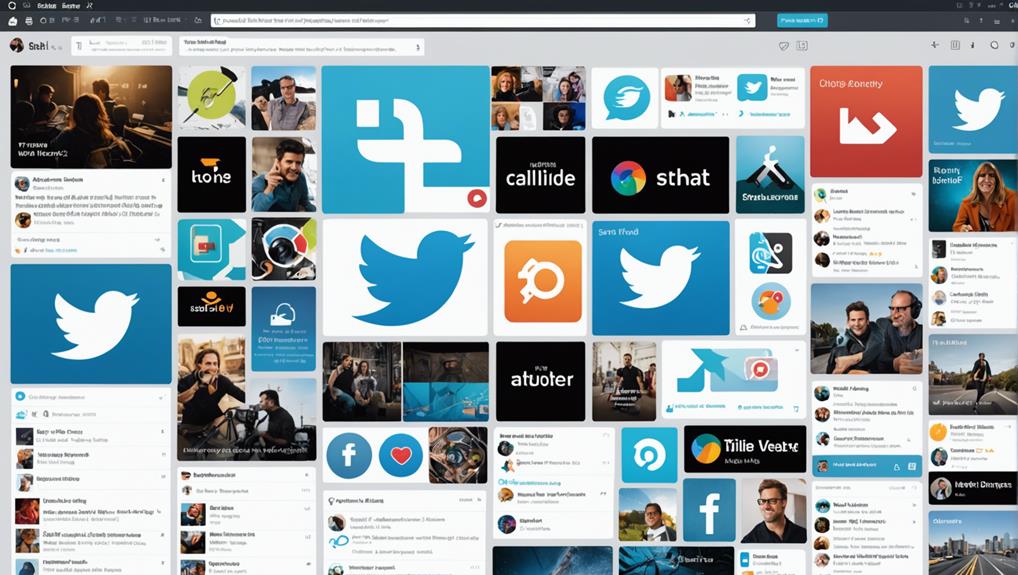Use Twitter Polls to boost engagement by crafting clear and concise questions that resonate with your audience. Keep your polls relevant and interactive, offering up to four response options. Leverage hashtags and collaborate with influencers to maximize visibility. Set clear objectives aligned with your broader strategy, and analyze the results for actionable insights. Engage with participants by responding to comments and sharing poll results. Promote your polls with visuals for added impact. To master these techniques and further refine your strategy, let's explore more.
Key Takeaways
- Craft clear, engaging questions aligned with audience interests.
- Use trending hashtags and visuals for wider reach.
- Define specific goals for meaningful insights.
- Share results to build trust and community.
- Collaborate with influencers for amplified engagement.
Understanding Twitter Polls
Twitter polls are a simple yet powerful way to engage your audience and gather valuable feedback. By incorporating a well-thought-out polling strategy, you can maximize audience engagement and extract meaningful insights.
Polls allow you to create interactive questions directly within your tweets, offering up to four response options. These responses are kept concise with a 25-character limit, ensuring clarity and ease of participation.
One of the key strengths of Twitter polls is their ability to tap into the collective voice of your audience while maintaining voter anonymity. This feature encourages more honest and uninhibited responses, giving you a clearer picture of audience sentiment.
The duration of each poll can be set for up to seven days, providing ample time for a wide range of followers to participate.
Twitter polls also serve as an excellent tool for real-time feedback. Whether you're gauging interest in a new product, seeking opinions on content, or simply engaging your followers with fun, interactive questions, polls can drive higher levels of interaction.
Since the results become publicly visible after the poll ends, they create a sense of anticipation and foster further engagement. By leveraging these tools strategically, you can deepen your connection with your audience and make more informed decisions.
Creating a Twitter Poll
To create an effective Twitter poll, start by crafting clear and engaging questions that resonate with your audience.
Next, choose the poll's duration, keeping in mind that you can run it for up to seven days depending on the engagement you seek.
Choosing Poll Questions
Crafting engaging poll questions starts with understanding your audience's interests and keeping the questions clear and concise. To maximize audience engagement, tap into your creativity by using relevant and timely topics. For instance, tying your poll questions to trending events or popular culture can greatly enhance participation. Ensuring poll question relevance is crucial; you want your audience to feel that their input matters and aligns with their interests.
To keep your poll questions effective, simplicity is essential. Avoid any ambiguity that might confuse respondents. Instead, aim for straightforward, easy-to-understand questions. This clarity not only encourages more responses but also ensures the data you gather is accurate and actionable.
Polls offer a fantastic way to gather feedback on your products, services, or content. By asking questions that explore your audience's preferences and needs, you can gain valuable insights. Consider using open-ended questions occasionally to prompt more thoughtful responses and foster deeper engagement.
Setting Poll Duration
Choosing the right duration for your poll is essential to maximize audience engagement and collect meaningful data. Twitter offers a flexible range for setting poll duration, from a minimum of 5 minutes to a maximum of 7 days.
Deciding how long your poll should run depends on your engagement strategies and the best timing for your target audience. When aiming for high participation rates, consider your audience's habits and activity patterns. Shorter polls, lasting a few hours to a day, are ideal for capturing quick audience responses on trending topics.
These polls harness the urgency and immediacy of Twitter's fast-paced environment, encouraging rapid engagement. For more thorough feedback, extending the poll duration to several days can be beneficial. This approach gives you ample time to promote your poll, ensuring it reaches a broader segment of your audience.
It also allows for thoughtful responses, enhancing the quality of the collected data.
Setting Poll Objectives
When setting poll objectives, start by defining clear goals that align with your desired outcomes.
Understand your target audience to craft questions that generate meaningful insights.
Define Poll Goals
Establishing clear poll objectives guarantees that your Twitter polls serve a specific purpose and achieve desired outcomes. Start by ensuring goal alignment with your broader social media and business strategies. This creates a cohesive poll strategy that seamlessly integrates with your overall objectives.
Whether you're looking to gather feedback, understand audience preferences, or drive engagement, having a well-defined purpose is essential.
Having a defined purpose allows you to craft poll questions that aren't only relevant but also engaging. For example, if your goal is to drive engagement, your questions should be designed to spark curiosity and interaction. This engagement drive can be a powerful tool for increasing your Twitter presence and fostering a more active community.
Moreover, well-defined goals make it easier to analyze the results effectively. You'll know exactly what you're looking for and how to interpret the data. This ensures that the insights you gain are actionable and aligned with your initial objectives.
Your poll objectives act as a roadmap, guiding every step from question creation to data analysis, making your Twitter polls a robust tool for audience engagement.
Target Audience Insight
Understanding your target audience is crucial to setting effective poll objectives on Twitter. When you know who you're speaking to, you can craft polls that truly resonate and drive audience engagement.
Start by defining clear goals, whether it's understanding customer preferences, gathering feedback on products, or gauging audience sentiment.
Your poll questions should be both relevant and engaging to extract the most valuable responses. For example, if you're looking to measure customer satisfaction, ask direct questions about their recent experiences.
Conducting market research? Frame questions that explore your audience's needs and desires. Curious about new product features? Use polls to gauge interest and capture targeted insights.
Balancing between general and specific questions can give you a detailed picture of your audience's preferences. General questions might reveal broad trends, while specific ones can pinpoint particular areas for improvement or innovation. This strategic approach ensures that your polls aren't just engaging but also actionable.
Measure Engagement Success
With a clear understanding of your target audience, it's time to set specific poll objectives to measure engagement success effectively. Establishing clear objectives is vital for gathering actionable insights and enhancing your engagement metrics.
Here are a few steps to guarantee your poll objectives are spot-on:
- Define Your Goals: Determine what you want to achieve, whether it's understanding audience preferences or gauging interest in a new product.
- Craft Relevant Questions: Align poll questions with your objectives to ensure the responses are meaningful and useful for data analysis.
- Analyze Results: Review the poll outcomes against your set objectives to identify trends, preferences, and areas for improvement.
- Optimize Future Content: Use the insights gained to make strategic decisions and refine your content strategy for better engagement.
Setting specific poll objectives helps in thoroughly analyzing poll results, making it easier to understand what resonates with your audience. By doing this, you'll be equipped to make data-driven decisions that can greatly improve your engagement strategies.
Crafting Poll Questions
Crafting poll questions necessitates a strategic approach to guarantee they capture your audience's interest and drive engagement. To master poll question dynamics and audience engagement strategies, you need to focus on clarity and relevance. A well-crafted question is clear, concise, and easy to understand, enhancing the likelihood of participation.
Using current trends or hot topics can make your poll more appealing. Tie your questions to what's buzzing in your industry or community to spark curiosity and interaction.
Employ creative wording techniques to make your polls stand out. Avoid jargon or overly complex language, and instead, use straightforward yet engaging phrasing. This aligns with polling best practices, ensuring your audience isn't confused or disinterested.
Balance is key—blend broad questions that appeal to your wider audience with niche questions targeting specific interests.
Lastly, design your questions with actionable insights in mind. What do you want to learn from your audience? Craft questions that not only engage but also yield meaningful data you can use to drive future content or business decisions. By following these strategies, you'll create poll questions that captivate your audience and drive valuable engagement.
Choosing Poll Options
Selecting the right poll options is essential for maximizing engagement and ensuring your audience feels their opinions matter. Twitter polls offer a maximum of four options, so use this range strategically to cover various perspectives.
Here's how you can make the most out of your poll options:
- Keep it concise: Each poll option can be up to 25 characters. Make sure your choices are clear and to the point.
- Use emojis in polls: Adding emojis can make your poll options more visually appealing and engaging. They can also help convey emotion or context quickly.
- Consider poll option formats: Decide whether your options will be binary (yes/no), multiple choice, or ranked preferences. Tailor the format to the question to get the most insightful responses.
- Ensure variety: Provide diverse choices to capture a wide range of opinions, but avoid overwhelming your audience with too many similar options.
Promoting Your Poll
To maximize participation, share your Twitter poll across various social media platforms and leverage relevant hashtags for increased visibility. Cross-promotion is key; don't limit your poll's exposure to just Twitter. Post it on Facebook, Instagram, LinkedIn, and even TikTok to tap into different audience segments.
Using popular and relevant hashtags in your tweets can greatly boost your Twitter poll engagement. Research trending hashtags in your niche and incorporate them to make your poll more discoverable. The right hashtags can draw in users who are interested in your poll's topic but may not follow you yet.
Collaborate with influencers or brands to amplify your poll's reach. Influencers with a large following can share your poll with their audience, driving more participants your way. This collaboration can be mutually beneficial, enhancing both your and the influencer's Twitter poll engagement.
Visual appeal is also important. Use eye-catching images or videos to make your poll stand out in the crowded social media landscape. A visually attractive poll is more likely to catch the attention of scrollers and encourage them to participate.
Engaging With Participants
Building on your promotion efforts, engaging directly with participants can turn a simple poll into a dynamic conversation hub. Your audience's feedback is invaluable, and by actively responding to comments, retweeting responses, and acknowledging their input, you can enhance your engagement strategies.
Here are some strategic ways to foster deep connections and build a thriving community:
- Respond to Comments: Show appreciation by replying to participants' comments. This makes them feel valued and encourages further interaction.
- Ask Follow-Up Questions: Keep the conversation going by posing additional questions based on the poll results. It's a great way to gather more audience feedback and dive deeper into their opinions.
- Use Multimedia Content: Enhance your polls with images or videos to make them visually appealing, capturing more attention and fostering engagement.
- Collaborate with Influencers: Partner with influencers or industry experts to increase participation and extend your poll's reach. Influencer collaborations can draw in new followers and add credibility to your polls.
Analyzing Poll Results
After analyzing your Twitter poll, explore the results to uncover valuable insights that can shape your future strategies. Start by reviewing the raw data to identify voting patterns and audience preferences. This initial step provides a snapshot of what your audience values and how they interact with your content.
Next, dig deeper by examining the conversations and interactions surrounding your poll. Look beyond the numbers to understand the context and nuances. This is where interpretation strategies come in handy. By analyzing comments, retweets, and likes, you can discern engagement trends and gauge the sentiment behind the votes.
To make the data more accessible and actionable, employ data visualization techniques. Graphs and charts can help you quickly spot trends and outliers, making it easier to communicate your findings with the marketing team. Visual tools also aid in comparing different polls over time, helping you refine your engagement strategies.
Implementing Insights
Armed with your poll analysis, you can now implement these insights to boost your engagement strategies and foster a more connected audience. Start by using the audience feedback to refine your content and engagement approach. This helps you align your strategies with what your audience truly wants, leading to increased loyalty and interaction.
Here's how you can leverage these insights:
- Tailor Content: Use the data to create content that resonates with your audience's interests and preferences.
- Adjust Posting Schedule: Identify when your audience is most active and schedule posts accordingly to maximize visibility and engagement.
- Enhance Product Offerings: Modify or introduce products/services based on the feedback to meet your audience's needs more effectively.
- Personalize Communication: Craft messages that speak directly to the sentiments and opinions expressed in the polls, making your audience feel heard and valued.
Enhancing Audience Interaction
To enhance audience interaction, start by crafting compelling poll questions that resonate with your followers.
Analyze the results to understand their preferences and behaviors, allowing you to tailor future content more effectively.
Crafting Compelling Poll Questions
Crafting persuasive poll questions is essential if you want to boost your audience's engagement on Twitter. To enhance audience interaction, start by employing clear, concise, and relevant questions. This approach will encourage your followers to participate and share their opinions, driving higher levels of engagement.
Here are some strategies to take into account:
- Incorporate Trending Topics: Tap into current events or hot-button issues to make your poll more relevant and timely.
- Balance Broad and Niche Questions: While broad questions can attract a wider audience, niche questions can provide targeted insights from specific segments of your audience.
- Use Engaging Language: Craft your questions in a way that captures attention and sparks curiosity.
- Seek Valuable Feedback: Frame your questions to elicit responses that can offer actionable insights or inform your content strategy.
Analyzing Poll Results Effectively
When you interpret poll results effectively, you reveal valuable insights that can drive strategic decisions and deepen audience engagement. Start by diving into data interpretation. Look beyond the surface numbers to understand the context of responses. What do your audience preferences tell you? Are there patterns or trends identifying a shift in their interests?
Next, transform raw data into actionable insights. This means not just noting what your audience likes but understanding why they like it. Engage with the comments and conversations surrounding your poll. This significant data can be as vital as the quantitative results.
Compiling these insights is the foundation for strategic planning. Share your findings with your marketing team to align your efforts. When everyone understands the audience's pulse, you can craft campaigns that resonate more deeply.
Collaboration doesn't stop there. Use the feedback to make continuous improvements. Every insight is an opportunity to refine your strategy and enhance audience interaction. By acting on their feedback, you show your audience that their opinions matter. This strengthens brand loyalty and builds a more engaged community.
Best Practices for Twitter Polls
For maximum engagement, use clear and concise language in your Twitter poll questions. It's important to keep your queries straightforward so your audience can quickly understand and respond.
Effective engagement strategies can greatly boost your audience interaction and participation.
To maximize the impact of your Twitter polls, consider the following best practices:
- Incorporate trending topics or relevant hashtags: This aligns your polls with current events and increases visibility.
- Share poll results: Transparency fosters trust and shows your audience you value their input.
- Engage with participants: Respond to comments and retweet interesting responses to create a sense of community.
- Utilize multimedia content: Adding images or videos makes your polls visually appealing and draws in more responses.
Frequently Asked Questions
Are Twitter Polls Good for Engagement?
Yes, Twitter polls are great for engagement. Keep poll frequency high and offer response incentives to boost participation. You'll see increased likes, retweets, and comments, creating a strong sense of community and driving conversations.
How Do You Engage Audience on Twitter?
You engage your audience on Twitter by starting hashtag campaigns and sharing eye-catching visual content. Combine trending topics with your hashtags and use compelling images or videos to capture attention, encourage retweets, and spark conversations.
How to Reach Your Target Audience on Twitter?
To reach your target audience on Twitter, focus on audience demographics and a strong hashtag strategy. Utilize advanced search features, engage with trending hashtags, and collaborate with influencers to enhance visibility and engagement effectively.
How to Get Maximum Engagement on Twitter?
To get maximum engagement on Twitter, post during peak times using an effective hashtag strategy. Engage with your audience by responding to comments and retweeting. Utilize trending hashtags to broaden your reach and visibility.
Conclusion
By effectively using Twitter polls, you can engage your audience, gain valuable insights, and enhance interaction. Remember to set clear objectives, craft compelling questions, and analyze the results to implement meaningful changes.
Following best practices guarantees your polls are effective and engaging. Keep experimenting and refining your approach to maximize impact. With these strategies, you'll foster a stronger connection with your audience and drive better engagement on Twitter.




